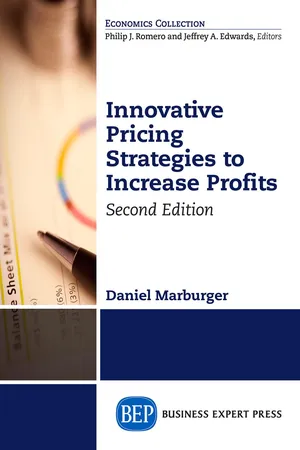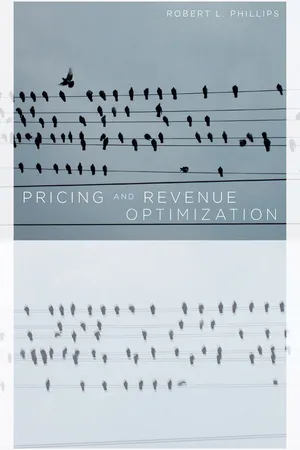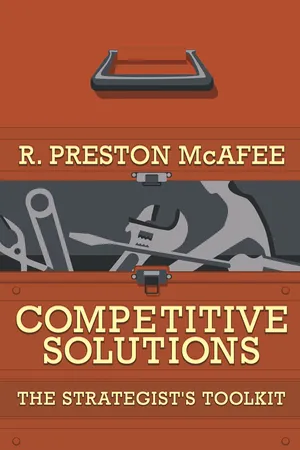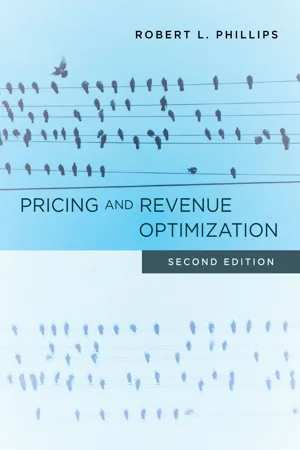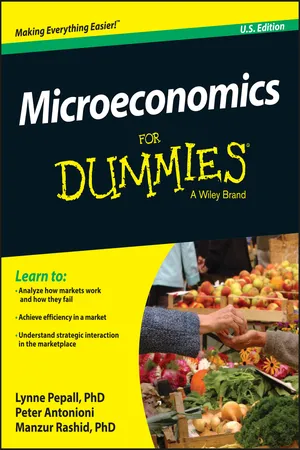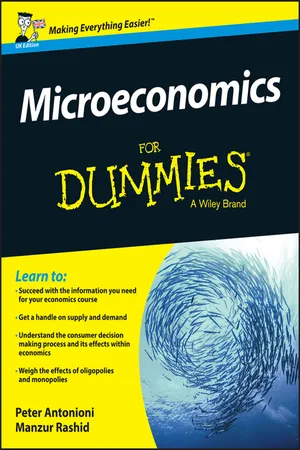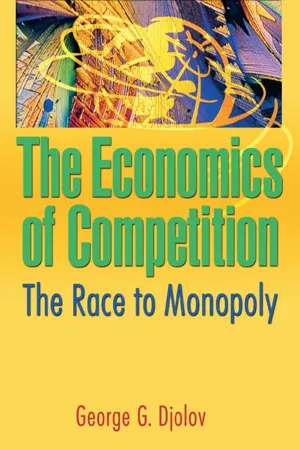Economics
Price Discrimination
Price discrimination refers to the practice of charging different prices to different customers for the same product or service. This strategy is often used to maximize profits by capturing consumer surplus and increasing overall revenue. Price discrimination can take various forms, such as first-degree (perfect) price discrimination, second-degree price discrimination, and third-degree price discrimination.
Written by Perlego with AI-assistance
Related key terms
Related key terms
1 of 4
Related key terms
1 of 3
11 Key excerpts on "Price Discrimination"
- eBook - ePub
Health Economics
Demystifying Healthcare Economics, Your Guide to Informed Decisions and a Healthier Future
- Fouad Sabry(Author)
- 2023(Publication Date)
- One Billion Knowledgeable(Publisher)
Chapter 6: Price Discrimination
Price Discrimination is a microeconomic pricing strategy in which the same provider sells identical or largely identical goods or services at different prices to different market segments. This is also known as one-to-one marketing. "Personalized pricing" (or first-degree price differentiation) refers to selling to each customer at a different price. "Product iteration""Group pricing" (or third-degree price differentiation) involves segmenting the market and charging each segment a different price (but the same price to each member of that segment). as well as senior discounts.Price Discrimination can only exist in monopoly and oligopoly markets in a theoretical market with perfect information, perfect substitutes, and no transaction costs or prohibition on secondary exchange (or reselling) to prevent arbitrage. Thus, Price Discrimination is prevalent in services where resale is not possible; student discounts at museums are an example. Theoretically, students may receive lower prices than the rest of the population for a particular product or service due to their status as students, but they will not later become resellers because they are required to present their student identification card when making a purchase. Intellectual property, which is enforced by law and technology, is an additional example of Price Discrimination. In the DVD market, laws mandate that DVD players be designed and manufactured with hardware or software that prevents cheap duplication or playback of content legally purchased elsewhere in the world at a lower price. In the United States, the Digital Millennium Copyright Act prohibits circumvention of such devices in order to protect the enhanced monopoly profits that copyright holders can obtain through Price Discrimination against higher-priced market segments.Customers' willingness to pay is differentiated by Price Discrimination in order to eliminate as much consumer surplus as possible. Using its market power, a business could determine the customers' willingness to pay by analyzing the elasticity of customer demand. - Daniel Marburger(Author)
- 2015(Publication Date)
- Business Expert Press(Publisher)
PART II Different Strokes for Different Folks: Charging More Than One Price for the Same GoodPassage contains an image CHAPTER 5 If You Could Read My Mind: First-Degree Price Discrimination Strategies
Readers are probably a step or two ahead of me. Why, one may ask, does Wendy have to charge all four clients the same price? Can’t she negotiate prices with each client individually? Indeed, she probably can. If she does, Wendy is engaging in Price Discrimination . Price Discrimination is the practice of charging different prices to different customers. Before we elaborate, let’s first identify what would not constitute Price Discrimination. In our simplified example, we assumed the cost of each job was identical. In the context of interior design, this isn’t a very realistic assumption. Some clients will want more elaborate design jobs than others. Consequently, one can reasonably expect that the price Wendy charges each client will be based on the cost of the job. This would not constitute Price Discrimination because the price variations across customers are based on cost differences across customers. Price Discrimination exists when the price differences are unrelated to cost differences; that the firm charges different prices to different customers because of differences in their willingness to pay. In essence, Price Discrimination is based on what we saw in Figure 4.1 : that under a single price strategy, some consumers are willing to pay more than the profit-maximizing price. Hence, these customers walk away with consumer surplus that the firm cannot capture with a single price. Price Discrimination is an attempt to capture some or the entire consumer surplus.The most extreme form of Price Discrimination is first-degree Price Discrimination (sometimes called perfect Price Discrimination ). Under first-degree Price Discrimination, each unit is sold for the highest price the market will bear. We can examine first-degree Price Discrimination by looking at the numbers in Table 5.1- eBook - ePub
- Robert O'Donoghue KC, Jorge Padilla(Authors)
- 2020(Publication Date)
- Hart Publishing(Publisher)
14 While these definitions leave open the question of when two goods are “different” or the “same,” they show the vertical character of Price Discrimination. Price Discrimination describes the practice of firms treating their (downstream) customers (either final consumers or buyers of an intermediate good) differently. (Similar analogies can be made with different non-price terms, but only price is dealt with here for reasons of simplicity.)Very often firms can and do price discriminate, often in astoundingly multifarious ways.15 For example, airlines generally operate complex yield-management systems whereby they try to differentiate ticket prices between customers based on time of purchase, ticket flexibility etc. Price Discrimination is an ubiquitous business practice,16 which, on its own, does not evidence market power.17 Even where there is market power, Price Discrimination is a type of behaviour that almost invariably enhances market efficiency, although not necessarily consumer welfare.18 No unambiguous a priori conclusions can, however, be drawn in respect of the effects of Price Discrimination on consumer welfare: an effects analysis is necessary in each case.15.2.1 Conditions For Price DiscriminationOverview. Price Discrimination is very common, but not universal. It is only possible under certain conditions. These are the ability to: (1) sort customers according to their valuation; and (2) prevent arbitrage between customers. There is no general agreement, however, on whether market power is necessary for Price Discrimination: many studies suggest that it is not and that it occurs in competitive markets too.19Condition #1: customers can be sorted. The most obvious pre-requisite for Price Discrimination is that suppliers are able to sort customers so that those with a higher valuation for the good are charged a higher price. Suppliers can sort customers in a number of ways—a fact recognised almost a century ago by Pigou:201. First-degree Price Discrimination . It is relatively straightforward for suppliers to sort their customers when the terms of sales are settled through individual negotiation. In this case, sellers can tailor the price to fit the preferences and outside options of each individual customer. This is known as first-degree Price Discrimination. First-degree Price Discrimination is common when selling intermediate and industrial goods, for example in the sale of commercial aircraft.21 - eBook - ePub
- Robert Phillips(Author)
- 2005(Publication Date)
- Stanford Business Books(Publisher)
4
PRICE DIFFERENTIATION
In this chapter we treat one of the most fundamental concepts in PRO—price differentiation . Price differentiation refers to the practice of a seller charging different prices to different customers, either for exactly the same good or for slightly different versions of the same good. Price differentiation is a powerful way for sellers to improve profitability. It also adds a new level of complexity to pricing, often creating a need to use analytical techniques to improve the calculation and updating of prices over time.We use the term price differentiation to refer to the ways that additional profit can be extracted from a marketplace by charging different prices. Tactics for price differentiation include charging different prices to different customers (or groups of customers) for exactly the same product, charging different prices for different versions of the same product, and combinations of the two. The term Price Discrimination is used in the economics literature to refer to much the same thing. We use the term price differentiation , rather than the more common Price Discrimination , in part to avoid the negative connotations associated with the word discrimination . However, we also want to stress that price differentiation includes not only charging different prices to different customers for the same product (group pricing) but also the less controversial strategies of product versioning, regional pricing, and channel pricing.There is both art and science to price differentiation. The art lies in finding a way to divide the market into different segments such that higher prices can be charged to the high-willingness-to-pay segments and lower prices to the low-willingness-to-pay segments. There is no one way to segment customers that applies to all possible markets. Instead, there is a variety of techniques that can be applied in different ways, depending on the characteristics of a market, the competitive environment, and the character of the goods or services being sold. The science lies in setting and updating the prices in order to maximize overall return from all segments. - eBook - ePub
Competitive Solutions
The Strategist's Toolkit
- R. Preston McAfee(Author)
- 2009(Publication Date)
- Princeton University Press(Publisher)
American Airlines excels at the phenomenon known as Price Discrimination, which means charging different customers different prices for the same good. The Internet offers new opportunities and new challenges for pricing. Customer histories will be available to some firms, offering the opportunity to base price offers on the history of the customer’s purchases. In particular, it becomes possible to offer higher prices to those who have shown, by their previous purchases, a willingness to pay a price higher than the market price. (It is a better idea to offer discounts to price-sensitive customers rather than add surcharges to those whose history suggests a tolerance for higher prices.) This chapter is concerned with pricing strategies, the largest component of which is Price Discrimination, sometimes known as value-based pricing, which involves charging what the market or individual submarkets, will bear. There are two major flavors of Price Discrimination strategy—direct and indirect. 1 Direct Price Discrimination involves charging customers different prices based on observable characteristics of the customer. A senior-citizen discount at a movie is an example of direct Price Discrimination, as is the Hertz rental car “gold” agreement offered free to high-level frequent flyers. Discounts offered to corporate buyers are also direct Price Discriminations. All of these differences in prices depend on observed differences in the customer type—their age, flying pattern, or employment. Indirect Price Discrimination involves making offers that are available to all, and letting customers choose which offer is best for them. The classic example of indirect Price Discrimination is the quantity discount, such as “buy one and get the second at half price.” Newspaper coupons are also examples of indirect Price Discrimination, for the coupons are available to all and customers choose whether to use them or not - eBook - ePub
Pricing and Revenue Optimization
Second Edition
- Robert L. Phillips(Author)
- 2021(Publication Date)
- Stanford Business Books(Publisher)
6 PRICE DIFFERENTIATIONIn this chapter we examine one of the most fundamental concepts in pricing and revenue optimization—price differentiation . Price differentiation refers to the practice of a seller charging different prices to different customers, either for exactly the same good or for slightly different versions of the same good. It can be a powerful tactic for sellers to improve profitability. It also adds a new level of complexity to pricing, often driving the need to use analytical techniques to improve the calculation and updating of prices over time. Price differentiation can also be dangerous if not managed correctly—it can lead to loss of profit through arbitrage and to negative reactions to pricing that some customers may perceive as unfair.Tactics for price differentiation include charging different prices to different customers (or groups of customers) for exactly the same product, charging different prices for different versions or amounts of the same product, and combinations of the two. It also includes charging different prices for combinations of products than for individual products sold separately. I use the term “price differentiation” rather than the standard economic term Price Discrimination in part to avoid the negative connotations associated with the word “discrimination.” However, I also want to stress that price differentiation includes not only charging different prices to different customers for the same product (group pricing) but also the less controversial strategies of product versioning, regional pricing, channel pricing, and nonlinear pricing.While “price differentiation” and “dynamic pricing” are often used interchangeably, there is an important distinction between the two concepts. Price differentiation refers to strategies for charging different prices to different customers based on differences in their willingness to pay. Price differentiation usually (but not always) means that different prices are in play for the same (or very similar products) at the same time. Dynamic pricing, on the other hand, refers to changing the price of a product over time. Dynamic pricing is often employed to balance supply and demand—as in the case of the variable-pricing approaches discussed in Chapter 7 - eBook - ePub
- Lynne Pepall, Peter Antonioni, Manzur Rashid(Authors)
- 2016(Publication Date)
- For Dummies(Publisher)
These challenges are less daunting with the advent of online transactions, big data, and auction-style markets. Now first degree Price Discrimination is much simpler. Firms can now track customers and learn a lot about their willingness to pay — and in the case of services like airlines, you can easily prevent resale of the ticket.Just because charging everybody different prices may be technically possible, please don’t get the idea that it’s always feasible in practice. Amazon, among other companies, has fallen afoul of customer complaints when customers noticed different prices being quoted to different customers and judged this to be an unfair practice.Second degree Price Discrimination: Non-linear pricing
In second degree Price Discrimination, the price per unit paid by a consumer depends upon how much of the good (how many beans) the consumer buys.Bulk discounts are an example. Here, the general principle is that the largest purchaser pays a lower per unit price because he buys a large quantity, whereas a consumer who buys a small quantity is charged a higher per unit price. The packaging of the goods makes it difficult for arbitrage — that is, difficult for the large purchaser to unbundle the package and resell it in smaller packages at a profit. Under second degree Price Discrimination, if two different consumers buy the same amount of the good, they pay the same amount. Differential pricing is based on quantity purchased by the consumer.In contrast to first degree Price Discrimination, second degree Price Discrimination is relatively commonplace. Think for a moment about the market for soft drinks, typically sold by the wholesaler in cases of 24 cans. Suppose you operate a corner shop and sell, say, 5 cases a week, and charge a retail price of $1 per can. The wholesaler charges you $12 a case, making the cost to you equal to 50 cents per can. But now suppose the new supermarket around the corner is one branch of a large chain ordering 5,000 cases a week, and as a result the wholesaler is willing to charge only $5 a case. The cost to the supermarket of a can of soda is less than half yours. The supermarket can now undercut you while still making more money per can. - eBook - ePub
Essentials of Pricing Analytics
Tools and Implementation with Excel
- Erik Haugom(Author)
- 2020(Publication Date)
- Routledge(Publisher)
Phillips (2005) prefers the former because it avoids the negative connotations associated with the word discrimination. Additionally, many authors stress that Price Discrimination/differentiation is about charging different prices for similar goods/services to different consumers. In the definition used here, we have deliberately omitted this part. The reason is that price differentiation can also be carried out for the same consumer. This is especially linked to what is called second degree price differentiation and is discussed later in this section. 2 A non-vertical shape of the price–response function means that the firm faces finite customer responses and, hence, operates in a market without perfect competition. This in turn means that the firm has at least some market power and that it has active pricing decisions to make. In theory, a firm could operate in a market without perfect competition and still face infinite customer responses (vertical price–response function). In this case, the price elasticity of the demand of the product or service of interest is perfectly elastic. We shall return to the concept of price elasticity of demand in Chapter 5. 3 This is an unlikely situation in the real world of course, but we shall use the assumption to illustrate an important point. - eBook - ePub
Pricing on Purpose
Creating and Capturing Value
- Ronald J. Baker(Author)
- 2010(Publication Date)
- Wiley(Publisher)
By engaging in Price Discrimination, airlines are able to offer a range of prices encompassing more of the demand curve, which actually allows lower income individuals access to more seats than would be the case if they had a one-price policy, which is why so many more millions fly today than 30 or 40 years ago. A world without Price Discrimination is a world where children would pay the same as adults, no coupons would exist to induce lower-income customers to purchase, no sales would take place, and senior citizens would not receive discounts (why else does one join AARP?). It would be a world where those who value a product more would pay a lower price while those with lower incomes would be prevented from purchasing a product with a lower value to them.If you pay close to attention to pricing methods, you soon discover Price Discrimination is nothing new; it has a long history. In the days of the railroads, third-class carriages—which were among the cheapest priced tickets—were placed in front of the train where passengers had to tolerate cinders in their hair and eyes since there were no roofs or seats. This is an inherent value trade-off for a lower price. For nonhuman cargo, railroads soon discovered they could charge based on the nature of the cargo, not just its weight—which is what drives costs—a form of customer segmentation to identify less price-sensitive shippers. Even Amtrak and the Eurostar Chunnel engage in Price Discrimination, a governmental nod to the efficiency and fairness of this free market practice. Let us look at other innovative examples of this practice, all the while noticing how these various examples segment customers, overcome the four hurdles to Price Discrimination, and identify which degree of Price Discrimination is being used, as discussed in Chapter 14.2United States Postal Services
The United States Postal Services (USPS), as well as other services around the world, recognize not all customers are equal by offering first-class rates, bulk rates, postcard, and book rates. Even though mass mailers have lobbied to get their bulk-rate stamps to look like first-class stamps—in order to get customers to open them—the USPS refuses, recognizing the different value offered. - eBook - ePub
- Peter Antonioni, Manzur Rashid(Authors)
- 2015(Publication Date)
- For Dummies(Publisher)
Bulk discounts for large purchases is an example. Here, the general principle is that the largest purchaser can be charged the marginal cost for the good, and any firms buying smaller quantities than the largest purchaser get charged inversely with the size of their purchase. Note that economists usually place the restriction that if you buy the same amount of the good, you pay the same amount, and so the bulk discount only applies to people buying larger quantities.In contrast to first degree Price Discrimination, second degree Price Discrimination is relatively commonplace. Think for a moment about the market for carbonated cola. It’s typically dispatched by the wholesaler in palettes of 24 cans. Suppose the retail price is £1 a can. You operate a corner shop selling, say, 5 palettes a week, and you pay the wholesaler £12 a palette, making the cost per can 50 pence. But the new supermarket around the corner is one branch of a large chain ordering 50,000 palettes a week, and as a result the wholesaler is willing to charge the marginal cost of production, say 10 pence a can.The supermarket can now undercut you while still making more money per can; for instance, it can set a markup of 60 pence (as opposed to your 50 pence) but a market price of 70 pence a can.Second degree Price Discrimination in the form of bulk discounts like this is often a reason behind such differences in the retail market.Third degree Price Discrimination: The student discount
In third degree Price Discrimination the monopolist segments the market into different groups, and while members of a group pay the same price as each other, the individual groups pay different prices from each other group.To dig a bit deeper, the monopolist charges the higher price to the group with the less elastic demand (who reveal themselves as willing to pay a little bit more). Our example here comes from our experience with students, who often tell us that they don’t have much money (especially when it’s their round!). Not having resources makes them a little more willing to shop around, which leads economists to suspect that their demand is more elastic. - eBook - ePub
The Economics of Competition
The Race to Monopoly
- George G Djolov(Author)
- 2014(Publication Date)
- Routledge(Publisher)
3 In view of this closeness nothing, in terms of the principles presented in this work on the topic of third-degree Price Discrimination, conflicts with what would be found if Ramsey pricing were to be considered instead. Nonetheless, we must be mindful of a similarity and a distinction here. The similarity relates to thinking of Ramsey pricing and third-degree Price Discrimination as producing efficient prices, i.e., those that minimize DWL, in the short run. Thus, both Ramsey prices and third-degree prices provide greater total consumer surplus than does a regimen of uniform pricing, which seems more likely to be the consequence of a state interventionist policy than market forces. The distinction relates to seeing that, although third-degree prices and Ramsey prices are those which raise overall consumer surplus in the short run, they do so differently. In third-degree Price Discrimination this is achieved by the firm's (provider) unconstrained maximization of profits. This requires unrivalled market power and brings us full circle to our conclusion that acquiring such power where government support is absent requires innovations of lasting distinctiveness in their technological, organizational, or product sense. However, the longevity of such power is questionable. It tends to be the case that, where the competitive process is not encroached upon statutorily, acceptable or readily available substitutes to what a firm with monopoly power has or makes will be found or made. This brings us to Ramsey pricing, where the increase in overall consumer surplus is achieved by the firm (provider) maximizing profits by practicing third-degree Price Discrimination, subject to constraints that business activities as mundane as the vying for market share, in all their variations and manifestations, seem certain to impose.From the difference in the way Price Discrimination is practiced between third-degree and Ramsey pricing, i.e., with and without constraints on firm profit and what this carries with it, it can be said that it seems, on the whole, that the innovation mechanism gives rise to Price Discrimination. Combining this with the innovation rationale referred to earlier, it appears that Price Discrimination and innovation are inseparable, i.e., the existence of one secures the other and vice versa. A gentler means of Price Discrimination comes into existence as the transfer mechanism gains ground or becomes more operative than the innovation mechanism. Then third-degree Price Discrimination moves toward Ramsey pricing.
Index pages curate the most relevant extracts from our library of academic textbooks. They’ve been created using an in-house natural language model (NLM), each adding context and meaning to key research topics.
Explore more topic indexes
Explore more topic indexes
1 of 6
Explore more topic indexes
1 of 4

